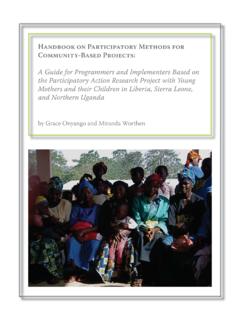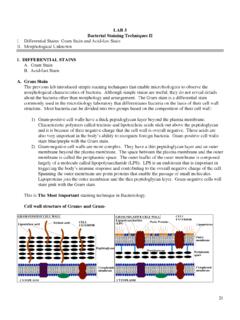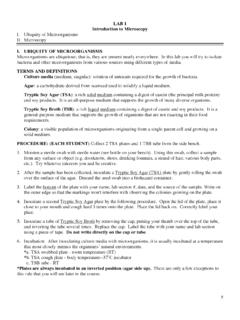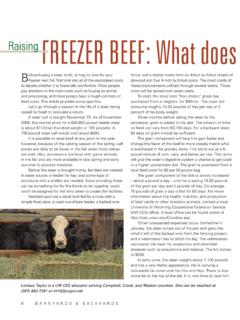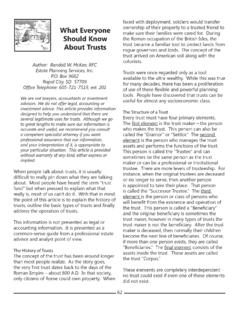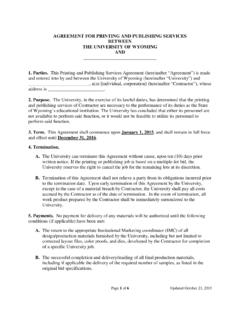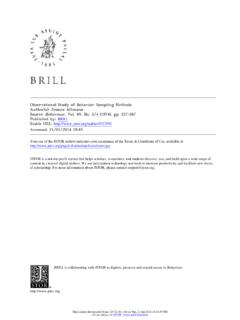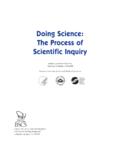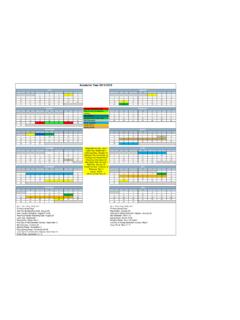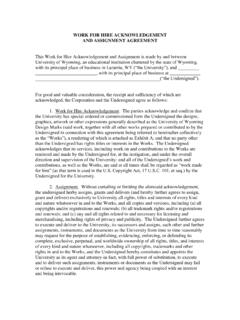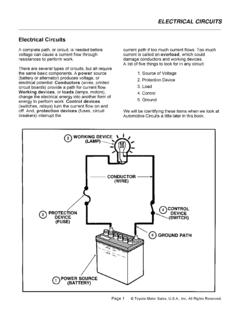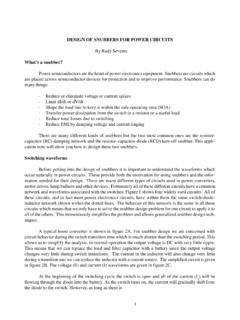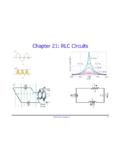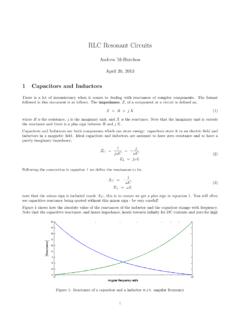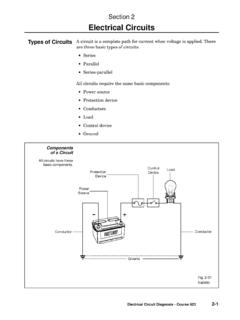Transcription of Lesson Plan: Electric Circuits (~130 minutes) Concepts
1 university of wyoming Science Posse Fun With Electricity Luke Dosiek This Lesson plan was developed with support from the National Science Foundation (G-K12 Project # 0841298) and the university of wyoming . Lesson plan : Electric Circuits (~130 minutes) Concepts 1. Electricity is the flow of Electric charge (electrons). 2. Electric Charge is a property of subatomic particles. 3. Current is the movement of Electric charge. 4. Voltage is the Electric potential that exists to move a charge. 5. Power is the rate at which Electric energy is flowing in a circuit . 6. Ohm s Law: Power = Voltage x Current. 7. Resistance is a physical property that quantifies how well a charge can move through a material. 8. Ohm s Law: Voltage = Current x Resistance.
2 9. Electric Circuits provide a means to harness electrical energy and use it in our everyday lives. 10. Circuits require a voltage source to operate. 11. Circuits require a closed loop to operate; that is they need a path for the Electric current to return to its source. 12. Circuits can be connected in either series or parallel. 13. Components connected in series have identical current, but different voltage. 14. Components connected in parallel have identical voltage, but different current. Key Questions 1. What is electricity? 2. What are Electric charge, current, voltage, and power, and how are they related? 3. Can current flow without a voltage source? 4. How does the resistance of a material determine how much Electric current flows through it?
3 5. Will current flow through an open (disconnected) circuit ? Why or why not? 6. What is the difference between series and parallel connections? 7. Where do we find Electric Circuits in our lives? Student Learning Objectives Standards Students will be able to explain how Electric current flows in a circuit . WYO , ; Benchmarks 13 and 14 Students will be able to wire a basic circuit . Students will be able to take measurements on a circuit . Students will be able to explain the difference between series and parallel connections. university of wyoming Science Posse Fun With Electricity Luke Dosiek This Lesson plan was developed with support from the National Science Foundation (G-K12 Project # 0841298) and the university of wyoming .
4 Anticipatory Set Electricity and Electric Circuits are all around us. Discuss examples of Electric Circuits and electricity. In order to further explore the Concepts of electricity a basic knowledge of the Electric circuit is required. Electrical engineers work daily with Circuits . Key Terms Electricity Charge Coulomb Current Ampere Voltage Resistance Ohm Power Watt Ohm s Law circuit Series Parallel Teaching plan General plan o Part 1: Introduce electricity o Part 2: The Electric circuit o Part 3: Electric circuit activity The accompanying PowerPoint presentation, , closely follows the following teaching plan . Part 1: Introduce electricity o Define electricity as the physical phenomena associated with the flow or movement of Electric charge.
5 (10 min.) This is just a definition. Let the students ask questions about electricity and discuss, leading them to the definitions and explanations below. o Define Electric charge as a fundamental property of some subatomic particles. (20 min.) Protons have a positive charge Electrons have a negative charge Neutrons have no charge (neutral) Particles of opposite charge are attracted to each other Particles of negative charge are repelled Use North and South magnetic poles as an analogy The SI (Le Systeme International) unit for charge is the coulomb (C) It takes x 1018 protons to equal one coulomb! university of wyoming Science Posse Fun With Electricity Luke Dosiek This Lesson plan was developed with support from the National Science Foundation (G-K12 Project # 0841298) and the university of wyoming .
6 This is 6,250,000,000,000,000,000 protons! How many coulombs is x 1018 electrons? (negative one coulomb) The space around an Electric charge is called the Electric field. Explain that a conductor is something which freely allows the motion of Electric charge and an insulator is the opposite; it greatly resists the flow of charge. A buildup of Electric charge on an insulator creates static electricity. Use a balloon as an example demonstration. Rub the inflated balloon on someone s hair and watch the hair stand up in the presence of the excess charge! In a conductor, a buildup of charge will freely move through the conductor, resulting in Electric current. o Define Electric current as the flow of Electric charge.
7 (20 min.) Typically the Electric charge is in the form of electrons As a result, Electric current, and electricity in general, is often defined as the flow of electrons. This is not always a true definition, as Electric current can be the result of the flow of other charged particles, so it s best to stick with the idea that current is the flow of charge. In fact conventional current, which is what is used by all electrical engineers, is the flow of positive charge. The flow of charge in a current carrying wire is really just a flow of energy, transferred from one charged particle to the next. So it s not electrons racing through a wire, it s their charges. The actual electrons move much more slowly through the wire.
8 In fact their movement is called electron drift. Use Newton s Cradle as an example to help visualize this. university of wyoming Science Posse Fun With Electricity Luke Dosiek This Lesson plan was developed with support from the National Science Foundation (G-K12 Project # 0841298) and the university of wyoming . The momentum moving through the balls that forces the ball at the far end to move almost instantaneously is like the Electric current in a wire. The motion of all of the balls moving at once is like the actual motion of the electrons in the wire. The SI unit of current is the Ampere (A). Current is measured with an ammeter. Current can only flow in the presence of an Electric field, often provided by a voltage source o Define voltage as the Electric potential between two points.
9 (10 min.) It is the potential for an Electric field to cause an Electric current to flow. Going back the Newton s Cradle, the force of gravity that causes the first ball to move can be thought of as the voltage that causes the current to flow. The SI unit for voltage is the volt (V). How many volts are in a AA battery? ( V) the wall outlet? (120 V) the power lines in the street? (about 13,000 V) the large power lines? (up to 765,000 V) lightning? ( about 100,000,000 V) Voltage is measured with a voltmeter. o Define Electric power as the rate at which electrical energy is transferred. (5 min) The SI unit for power is the watt (W). Ohm s Law: Power = Voltage x Current o Define resistance as a physical property which describes how well Electric current flows in a material (5 min) The SI unit for resistance is the ohm ( ) Ohm s Law: Voltage = Resistance x Current o Go through a simple example of Ohm s law using a single resistor connected to a voltage source and calculate the current being drawn and the power being consumed.
10 (15 min) If a 5 resistor is connected to a 12V battery, how much current is drawn from the battery? Current = Voltage / Resistance = 12V / 5 = How much power is the resistor consuming? Power = Voltage x Current = 12V x = W Part 2: The Electric circuit o Define the Electric circuit as a connection of two or more components to form a closed loop. (5 min) university of wyoming Science Posse Fun With Electricity Luke Dosiek This Lesson plan was developed with support from the National Science Foundation (G-K12 Project # 0841298) and the university of wyoming . o The closed loop is necessary to allow the Electric current to flow from one point of the voltage source to the other (5 min) Remember, a voltage is the Electric potential between two points.
